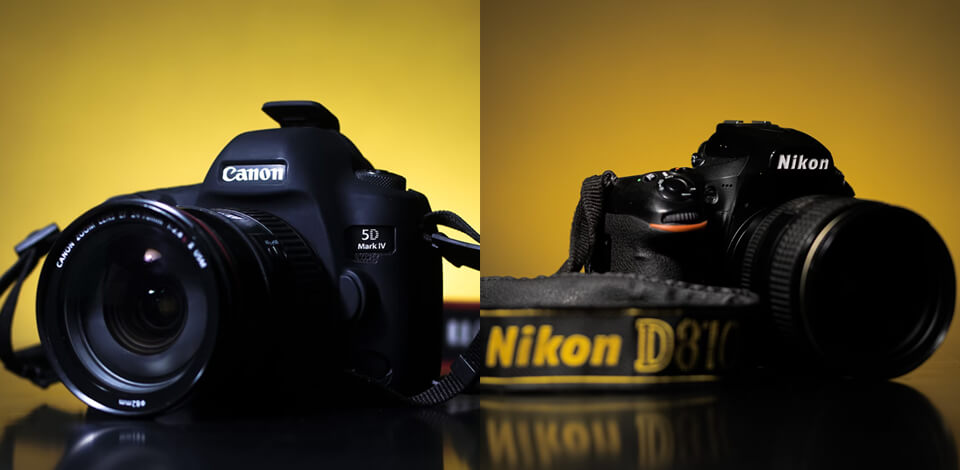
Is Canon better than Nikon? It’s generally the recommended option for photographers of all levels, particularly those who prefer to use mirrorless models. Meanwhile, Nikon is the superior option for people interested in time-tested DSLRs.
Canon responded to the mirrorless trend quicker and as such has managed to dominate this segment, providing far more high-quality models than the competitor does. However, Nikon is also constantly improving and regularly expanding its product line with new cameras.
| IMAGE | NAME | FEATURES | |
|---|---|---|---|

|
Canon EOS Rebel T100
|
CHECK PRICE → | |

|
Nikon D3500
|
CHECK PRICE → |
The Nikon vs Canon DSLR battle used to be the hottest on the markets, affecting photographers of any experience level. Since then, both brands have abandoned their DSLR lines. For users interested in getting a cheaper deal, this is good news, since you can find a high-quality new or used DSLR camera for a reasonable price.
When it comes to pricing, Canon is far above Nikon in this segment. The EOS Rebel T100 is the cheapest Canon camera. It's equipped with an 18MP 1" sensor, an optical viewfinder, and impressive ISO that allows you to work in low-light conditions.
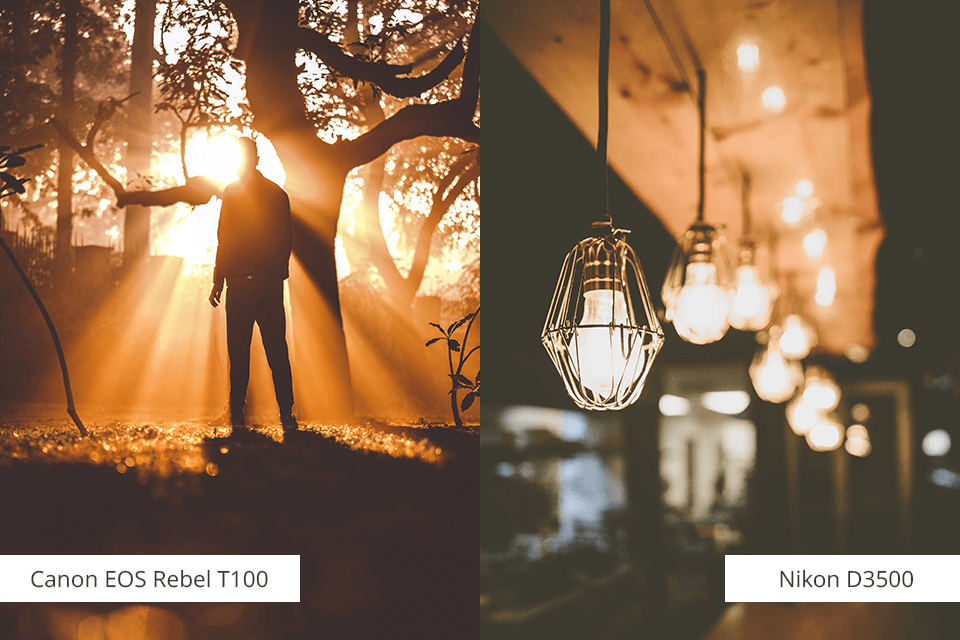
By adding $200 on top of that price, you can get a better, used model from Nikon. The Nikon D3500 is an entry-level DSLR that has a 24MP APS-C sensor. It's packed with easy-to-use features, including guided modes and a tiltable LCD screen. It's also a solid choice for shooting videos if you're into that.
| IMAGE | NAME | FEATURES | |
|---|---|---|---|

|
Canon EOS Rebel T7
|
CHECK PRICE → | |

|
Nikon D7500
|
CHECK PRICE → | |

|
Canon EOS 90D
|
CHECK PRICE → |
Both brands provide quality entry-level DSLRs. One of the key distinctions according to the users is that Nikon cameras typically offer superior autofocus than the competition.
Equipped with a big 24.1MP CMOS sensor, quick autofocus, integrated wireless connectivity, and other handy features, Canon EOS Rebel T7 offers terrific functionality and intuitive controls to help you take pro-quality photos with minimum effort. It also allows you to record Full HD footage in different framerates, including 30fps to ensure it looks smooth. This model’s broad ISO range makes it suitable for a variety of lighting conditions.
If you need a more advanced model, then check out the Nikon D7500. It’s the last released Nikon DSLR in the enthusiast segment. It’s an impressive Nikon photography camera that offers the terrific ergonomics and high component quality that this brand is known for. However, since it only has a resolution of 20.9MP, it’s not quite as impressive as some of Canon’s enthusiast-grade cameras like the EOS 90D.

The Canon EOS 90D sensor has a stunning resolution of 32MP, which is superior to most full-frame models. Additionally, it supports 4K video recording, which is why it’s considered to be among the best DSLR cameras for videographers.
| IMAGE | NAME | FEATURES | |
|---|---|---|---|

|
Canon EOS 6D Mark II
|
CHECK PRICE → | |

|
Nikon D850
|
CHECK PRICE → |
Canon was winning the Canon camera vs Nikon entry-grade full-frame DSLR battle for a long time due to the existence of the EOS 6D Mark II, an incredibly versatile model. This Canon camera for portraits comes with a 26.2MP full-frame CMOS sensor, fantastic ISO range, and a tiltable touchscreen.

That said, it can’t match the sheer power provided by the Nikon D850 and its 45MP sensor, 4K resolution support, and 8K time-lapse recording feature. This full frame camera also has a convenient LCD touchscreen and its battery charge lasts for up to 3,300 photos. Meanwhile, the weather-sealed case makes it suitable for taking pictures in all kinds of weather conditions.
| IMAGE | NAME | FEATURES | |
|---|---|---|---|

|
Canon EOS-1D X Mark III
|
CHECK PRICE → | |

|
Nikon D6
|
CHECK PRICE → |
Both brands highly value professional photographers and videographers, which is why they offer a comparable series of high-speed sports models.
However, when you look at the top offerings from both participants of the Canon vs Nikon battle, you can clearly see that the Canon EOS-1D X Mark III is the winner. This pro-grade Canon camera is supplied with cutting-edge functionality like the deep-learning autofocus system with unparalleled subject recognition and tracking, while its Smart Controller is far more convenient than the classic joystick. Additionally, it provides uncropped 4K and CFexpress Type B support, resembling a traditional camera but one that is aimed at the future.
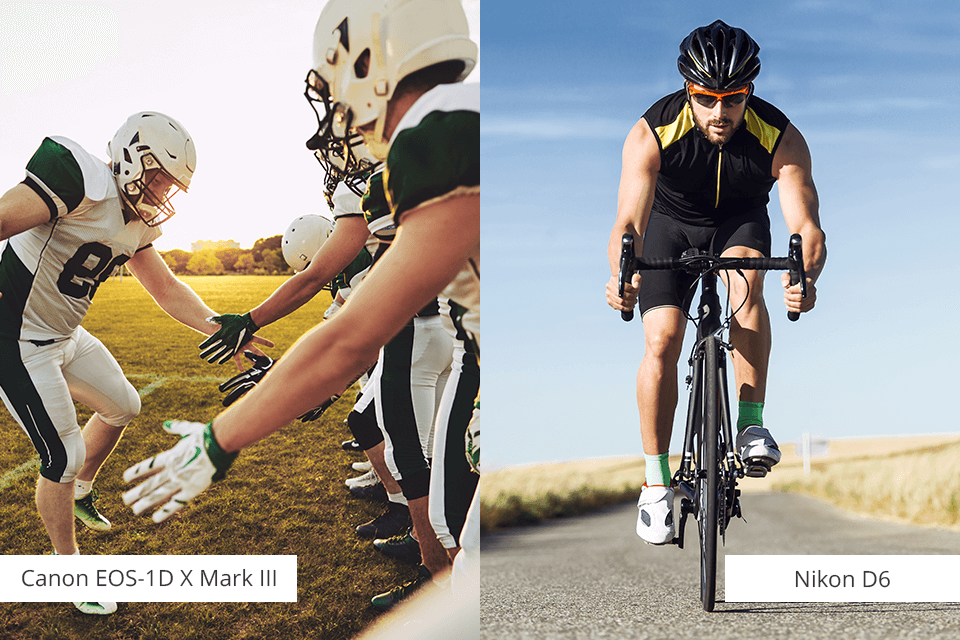
On the other hand, we have the Nikon D6, which is an all-round solid professional camera. Even though it doesn’t have the same smart features, this reliable, fast 14fps model is still perfectly suited for most tasks.
| IMAGE | NAME | FEATURES | |
|---|---|---|---|

|
Nikon Z50
|
CHECK PRICE → | |

|
Canon EOS R50
|
CHECK PRICE → |
Both companies are on the top of their game when it comes to releasing mirrorless cameras for beginners. These hugely popular models are significantly lighter and more compact than DSLRs due to the absence of the mirror component. Moreover, they come with superior functionality and multimedia features. Additionally, there are mirrorless cameras that are primarily designed for videography rather than just taking photos.
Nikon Z50 is very popular among beginner photographers and vloggers. It’s a small, light model that is packed with a 20.9MP APS-C sensor that is also capable of recording smooth 4K videos. Moreover, the Z50 boasts a high-speed autofocus and an articulating touchscreen. The only drawback of this camera is that it feels a bit dated at this point.
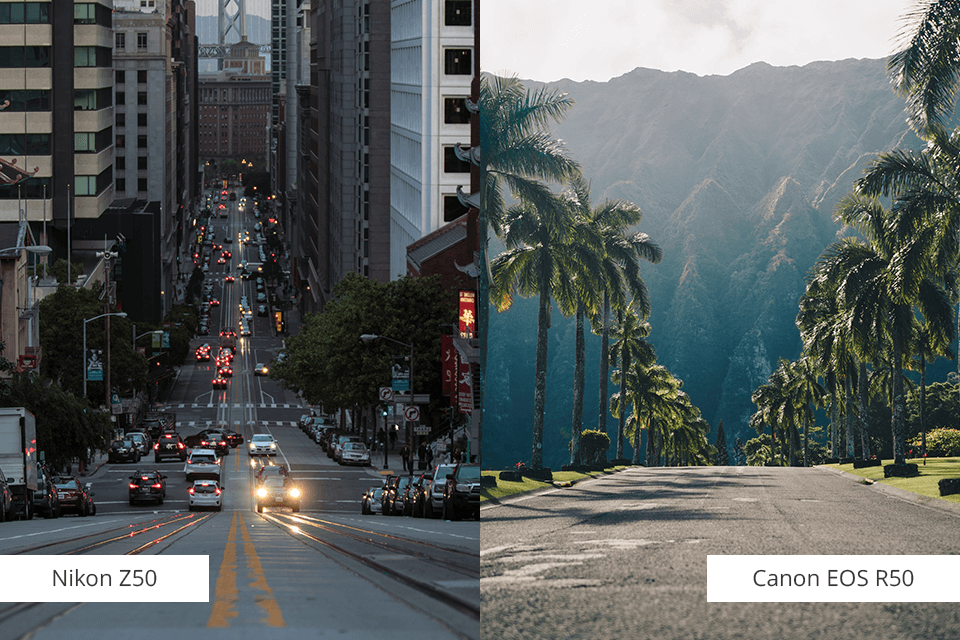
Canon EOS R50 offers a similar size to the Z50 while providing superior resolution, as it comes with a 24.2MP sensor. It’s also equipped with the brand’s proprietary Dual Pixel CMOS AF and has a continuous shooting mode that allows you to take 15 shots per second.
This Canon video camera is also very popular among videographers and vloggers. It allows you to record 6K oversampled footage as well as uncropped 4K videos with a maximum framerate of 30fps. Its Full-HD recording mode is capped at 120fps. The EOS R50 is the perfect tool for producing vlogs and YouTube content in terrific quality.
| IMAGE | NAME | FEATURES | |
|---|---|---|---|

|
Nikon Z fc
|
CHECK PRICE → | |

|
Canon EOS R7
|
CHECK PRICE → |
Nikon Z fc provides impeccable picture quality as well as vlogger-oriented functionality. Its most notable features include a variangle LCD, impressive autofocus with eye detection, and an integrated stereo mic – this camera has everything you need for video recording.
However, if you’re interested in an APS-C mirrorless camera, then you should turn your attention to Canon EOS R7. This model is suitable for almost any purpose imaginable, as it has a superb 32.5MP sensor, 30fps continuous shooting mode, 4K recording down-sampled from 7K, and dual SD card slots.
| IMAGE | NAME | FEATURES | |
|---|---|---|---|

|
Canon EOS RP
|
CHECK PRICE → | |

|
Nikon Z5
|
CHECK PRICE → |
The 26.2-megapixel Canon EOS RP is known to be user-friendly, small, and reasonably priced. It’s the cheapest full frame camera that comes with a fully articulating touchscreen and is perfectly suited for both photography and videography. However, it should be noted that the provided 4K recording is cropped (the same is true for the Nikon camera).
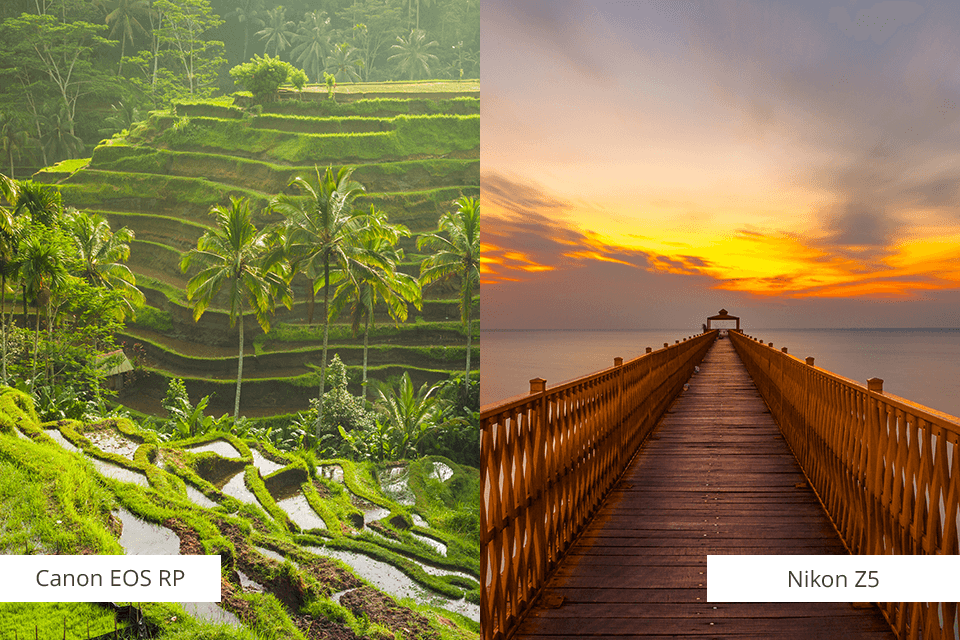
The 24.3 megapixel Nikon Z5 is a bit larger and bulkier than Canon’s model. It lets you host two memory cards, but its display is only tilting, not fully articulated. All other relevant parameters like ISO or continuous shooting speed are nearly identical to the competition, meaning it can be hard to decide if you should choose Nikon or Canon in this category.
| IMAGE | NAME | FEATURES | |
|---|---|---|---|

|
Canon EOS R5
|
CHECK PRICE → | |

|
Nikon Z9
|
CHECK PRICE → |
The Canon EOS R5 is the brand's most advanced offering, as it's supplied with a 45MP full-frame sensor. Moreover, thanks to the newest firmware update, you'll be able to take advantage of the High-Resolution Shot mode that allows you to combine multiple exposures to receive a single 400MP photo.
The video recording functionality provided by this model is also highly impressive. It lets you record footage in up to 8K resolution with zero cropping and a 30fps framerate.
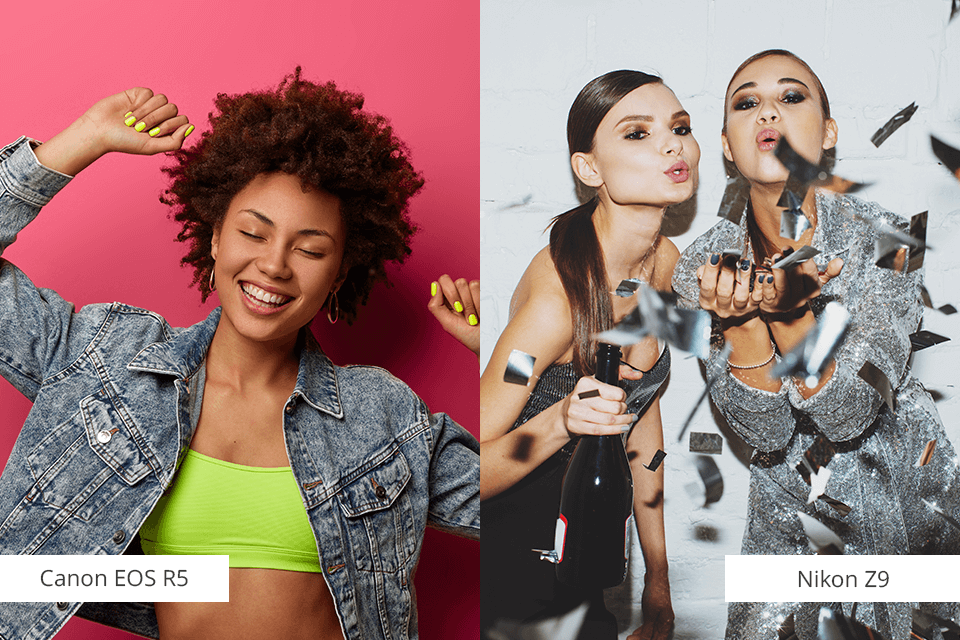
Nikon’s flagship in this segment is the Nikon Z9. Armed with a 45.7MP sensor, this camera gains an edge over the EOS R5 in terms of picture quality. While it doesn’t have a High-Resolution Shot mode, you can enjoy a continuous shooting mode with a maximum speed of 30fps in full resolution, which is an invaluable feature for any sports or event photographer.
It’s a large model with an integrated battery grip on the bottom, which is required to support all the advanced features packed into this camera.
Regardless of whether you’re a landscape, portrait, or event photographer, both brands will provide a variety of lenses that will satisfy all of your requirements. The provided lenses are all of impeccable quality, allowing you to take sharp, clear photos.
Deciding is Nikon or Canon better can be very difficult, as the primary difference between the two brands comes down to the autofocus. Nikon has taken away the AF system from entry-grade DSLRs to make them more compact. As such, you won’t be able to employ AF from the brand’s AF-S lenses if you get a beginner-category DSLR.
Additionally, it should be mentioned that while non-AF-S Nikon lenses are compatible with the brand’s DSLRs, they need to be focused manually.
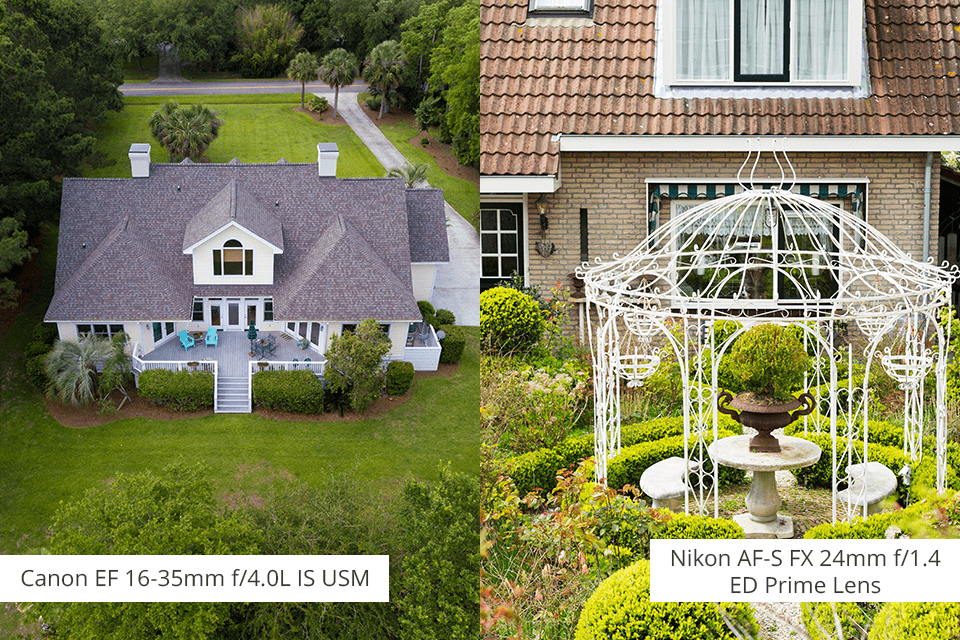
On the other hand, Canon lenses are equipped with AF motors, meaning you don’t have to rely on the camera body to provide it. As such, you’re able to employ older lenses with nearly all modern camera models.
When it comes to lenses for mirrorless cameras, Canon’s RF models offer full support for the R-series mirrorless cameras. This series isn’t as expansive as the EF category, but new RF lenses are introduced at a very frequent pace. It’s possible to find a suitable model for nearly all photography genres.
Nikon mirrorless cameras come with a Z lens mount that requires Z-series lenses. Similar to Canon, Nikon has a rather limited selection of lenses for mirrorless models compared to their DSLR lineups. Thankfully, this product line is growing all the time and the quality of each model is nothing short of impressive.
Wide Angle
Portrait
Prime
Telephoto
Macro
For Mirrorless Cameras
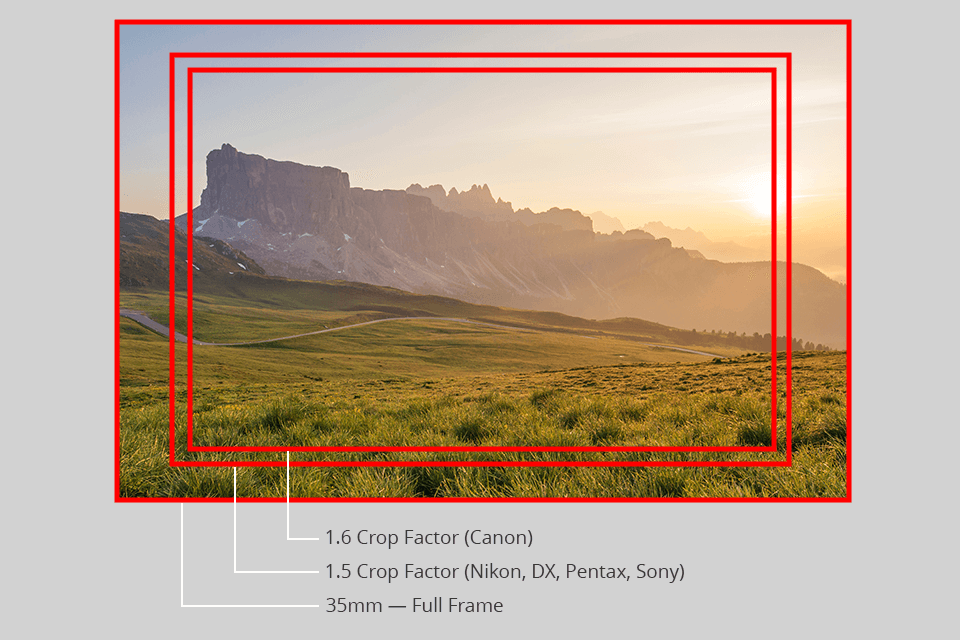
Both brands offer cameras with crop (APS-C) and full frame sensors. The size of a camera sensor determines how much light it can capture, which in turn affects the amount of detail and resolution it can produce. The crop factor of Nikon’s crop sensor models is 1.5x. For Canon, the crop factor stands at 1.6x.
The main benefit of a bigger sensor is that can receive more light, providing a more detailed photo and superior low-light results. The 0.1 crop factor margin between the two brands might seem unimportant but because crop sensors are already very tiny, even 0.1 can help significantly increase the resolution.
More compact sensors also offer superior magnification. If you’re doing sports photography, you can conveniently transform a 100mm telephoto lens into a 150mm one with a Nikon and a 160mm model with a Canon camera.

When it comes to interface, there are a few notable distinctions. Nikon cameras often have a rotary power switch located near the shutter button, which can be accidentally turned on or off. On the other hand, Canon cameras tend to have push buttons that unfortunately don't light up in the dark, which can be a bit inconvenient. So, both brands have their quirks in terms of interface design.
Both Canon and Nikon have well-designed menus, but they do have some differences. Nikon cameras have a settings dial with only two programmable settings, while Canon cameras offer four settings banks that can be easily recalled with just one press of a button. So, it's a matter of personal preference and convenience when it comes to navigating the menu system.
Moving on to performance and design, both Canon and Nikon cameras offer ergonomic designs and intuitive controls, although some models may have more advanced layouts than others. Canon's EOS R model, for instance, provides a customizable control dial for easy access to frequently used settings. Nikon's D850, on the other hand, has an i button for quick access to important camera settings.
Canon has a dominating presence in the APS-C DSLR and mirrorless camera categories for enthusiasts and beginners, with the large number of available options being one of the main reasons for such a disposition. Nikon's DSLR product line is also solid but hasn't seen any major innovations in the last few years, which is the case for both manufacturers.
Canon's color science is exceptional for portrait photography, delivering clean and neutral tones. Their autofocus is also known for being fast and accurate. On the other hand, Nikon boasts a reliable flash system. However, some users find Nikon cameras a bit more challenging to operate compared to Canon.
So, to sum it up, Canon and Nikon cameras have their similarities and differences. It ultimately comes down to personal preference, shooting style, and specific needs.